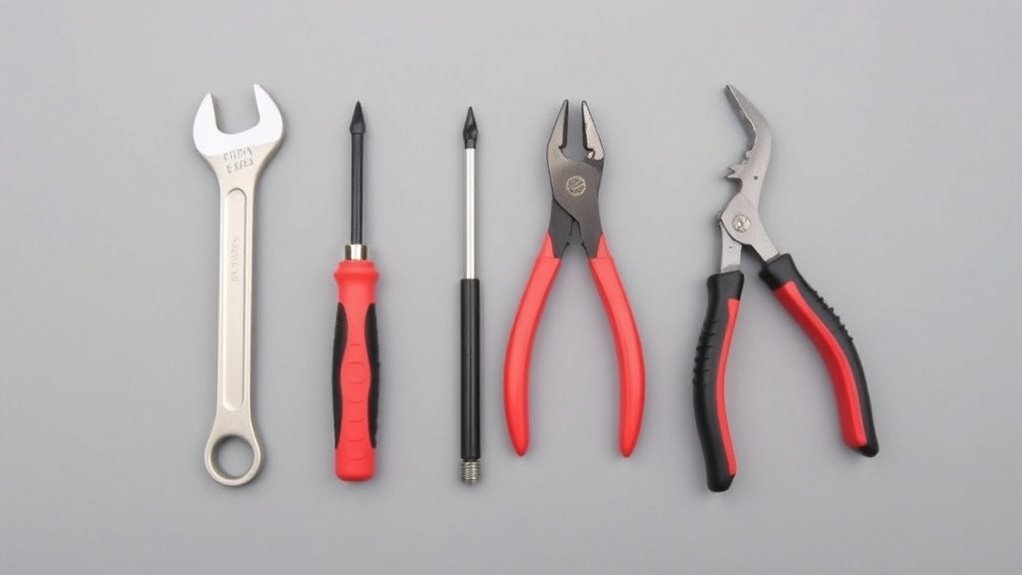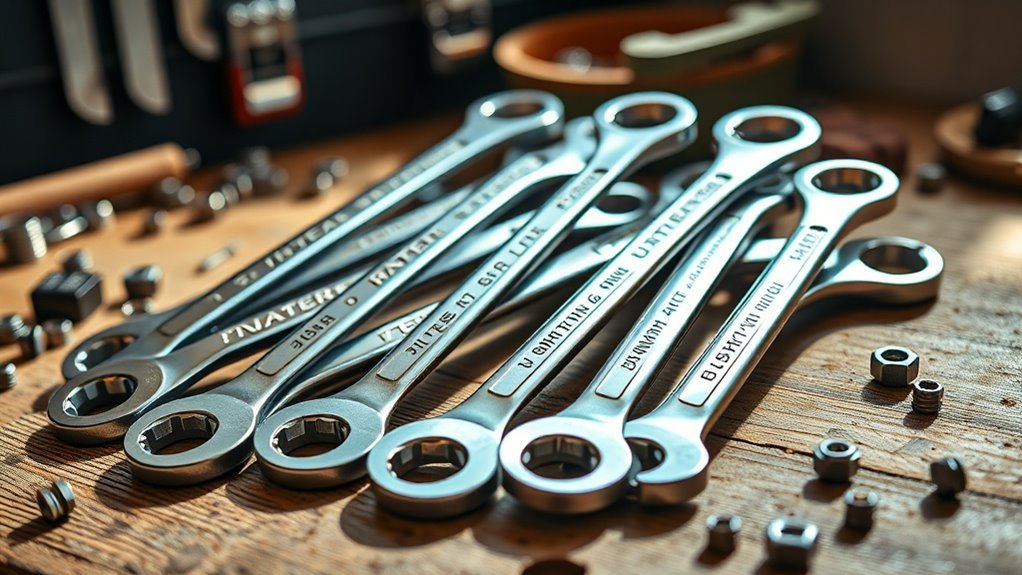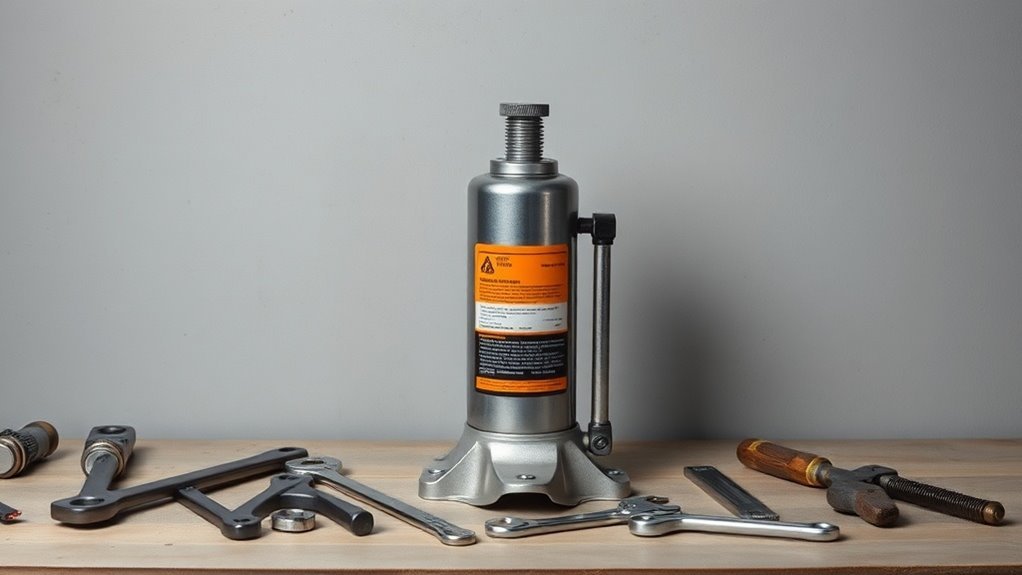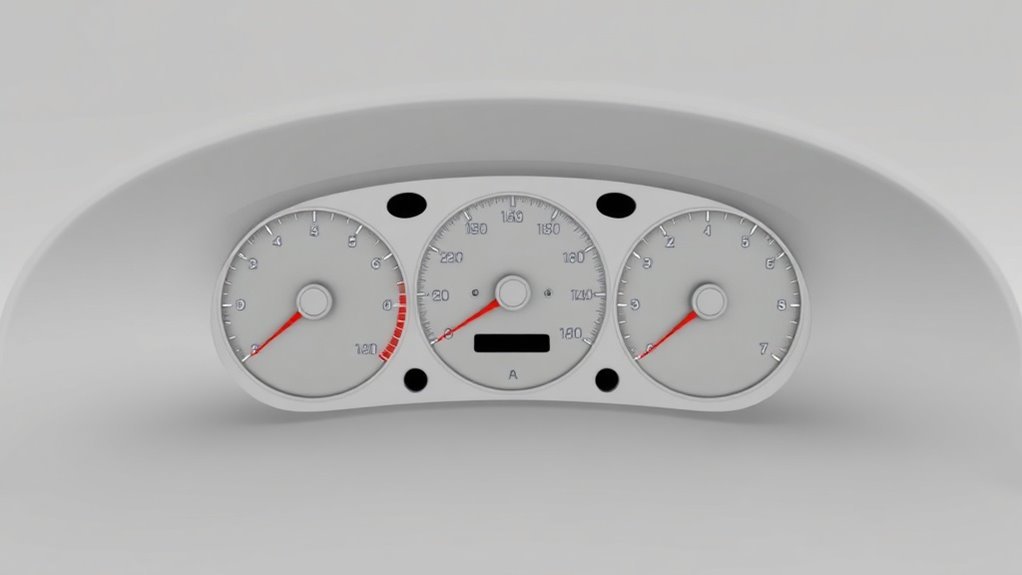How Tool Design Has Changed Over the Centuries
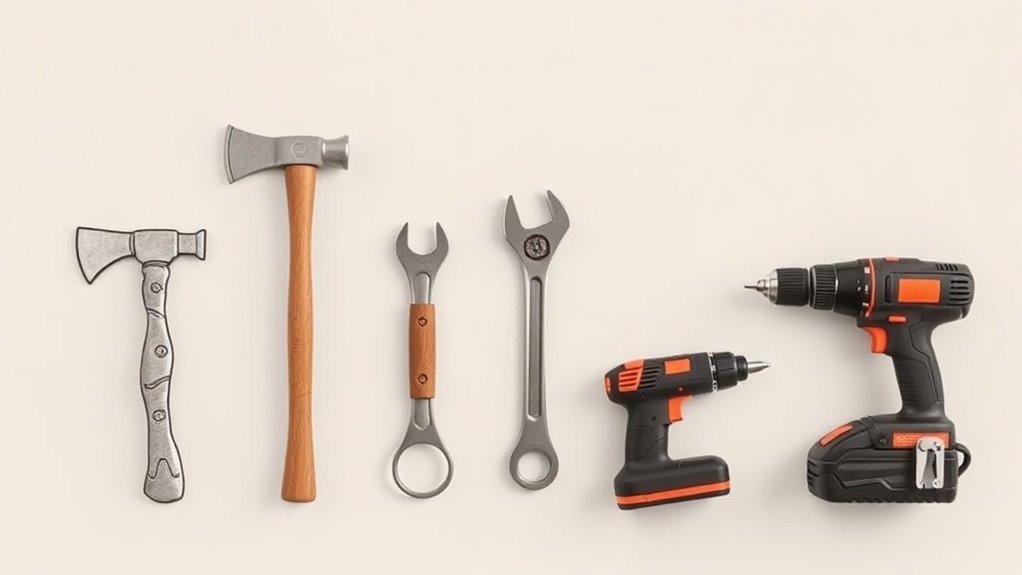
Tool design has transformed dramatically over the centuries. You started with simple stone tools for basic tasks, but as metalworking emerged, specialized tools began evolving. The Industrial Revolution then introduced mass production, making tools more accessible. With electricity, power tools revolutionized labor efficiency. Today, ergonomic designs enhance user comfort, while digital technology and sustainable materials push innovation further. If you explore further, you’ll uncover even more fascinating shifts and influences in tool design through history.
Key Takeaways
- Early hand tools were crafted from stone, evolving into specialized implements for hunting and building based on human needs and cultural growth.
- The advent of metalworking around 3,000 BCE introduced stronger, more durable tools, enabling advancements in agriculture, construction, and artistry.
- The Industrial Revolution implemented mass production techniques, leading to standardized tools and improved efficiency through interchangeable parts and assembly line work.
- Electricity transformed labor in the late 19th century, introducing power tools that increased productivity and simplified complex tasks in woodworking and construction.
- Modern ergonomics prioritize user comfort in tool design, emphasizing natural movement and reducing strain, enhancing overall productivity and reducing injuries.
The Dawn of Tool Making: Prehistoric Innovations
The emergence of tool making marked a pivotal moment in human history, shaping our ability to manipulate the environment. Imagine our ancestors chipping away at stones, crafting tools that would allow them to hunt, gather, and build.
These early innovations weren’t just practical; they set the foundation for social and cultural growth. You can picture a simple flint tool in hand, providing a sense of empowerment and survival.
Over time, these primitive tools evolved from hand axes to more specialized implements, reflecting changing needs and environments. This ingenuity not only improved daily life but also fostered collaboration among early humans, paving the way for advanced problem-solving.
As you explore this era, consider how these foundational tools influenced our technological journey.
Metalworking and the Birth of Specialized Tools
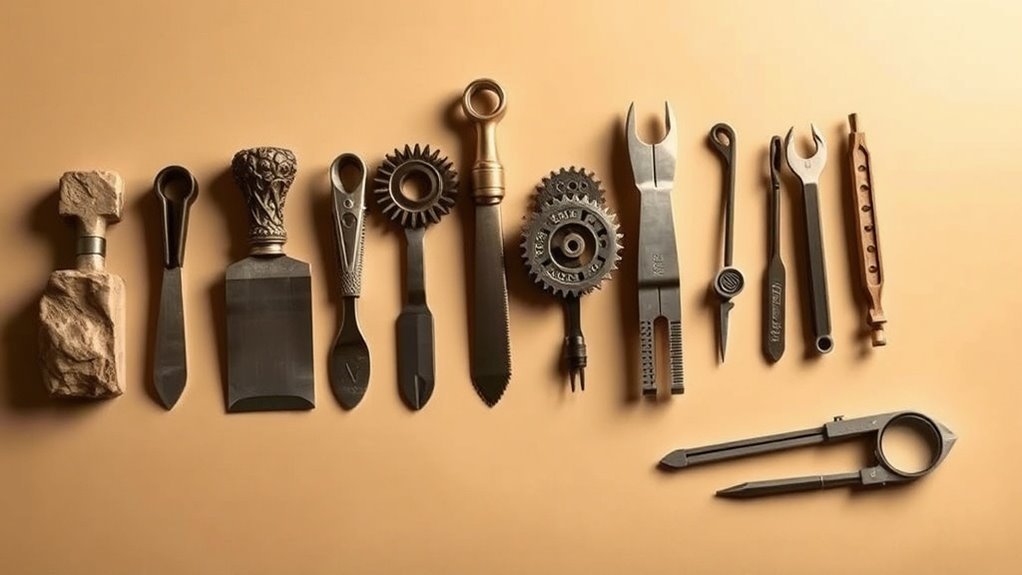
Crafting tools took a significant leap forward with the advent of metalworking around 3,000 BCE, forever changing how humans interacted with their environment.
Early metalworkers discovered that copper and tin could be forged into stronger, more durable tools than stone. You’d find specialized tools emerging, such as chisels, pickaxes, and saws designed for specific tasks, transforming everyday work.
The discovery of copper and tin revolutionized tool-making, giving rise to specialized implements that transformed everyday tasks.
This precision allowed craftsmen to create intricate designs in wood and stone, and as skills advanced, so did the complexity of tools. The ability to shape metal led to innovations in agriculture, construction, and artistic expression. This transition towards specialized tools enhanced productivity and made various tasks significantly more efficient.
Soon, metalworking became an essential craft, laying the groundwork for the advanced tool design we appreciate today. This era marked a thrilling evolution in functional artistry.
The Industrial Revolution: Mass Production and Standardization
As the Industrial Revolution unfolded in the late 18th century, it fundamentally transformed how tools were produced and used.
Mass production techniques became common, allowing manufacturers to create large quantities of standardized tools. This revolutionized industries, making tools more accessible and affordable for everyone.
You’d notice that interchangeable parts became a game-changer, enabling quicker repairs and modifications; it also meant that you didn’t need highly skilled craftspeople for every job. Instead, workers could focus on specific tasks in assembly lines, increasing efficiency.
The innovation didn’t just improve quality, but also fostered competition among manufacturers, pushing them to enhance designs continually. Moreover, the emergence of modular storage solutions further optimized the organization and efficiency of tool production, facilitating better workspace management.
The Advent of Electricity: Power Tools Transforming Labor
While the onset of electricity in the late 19th century wasn’t the only factor in tool evolution, it undeniably marked a significant shift that transformed labor.
Power tools became accessible, changing the way you worked and dramatically increasing productivity. No longer did you have to rely solely on hand tools, which consumed energy and time. Electric drills, saws, and sanders made tasks quicker and more efficient, allowing for larger-scale projects.
The advent of power tools revolutionized productivity, streamlining tasks and enabling larger projects with unmatched efficiency.
This shift didn’t just enhance the manufacturing process; it also influenced craftsmanship in woodworking, construction, and beyond. You could now accomplish complex tasks with precision, revolutionizing trades and tradespeople. Furthermore, the introduction of energy-efficient tools has contributed to sustainability efforts in the industry.
Ultimately, electricity propelled labor into a new era, paving the way for innovations we often take for granted today.
The Rise of Ergonomics: Tools Designed for the Human Body
Given that traditional tools often led to strain and injuries, the rise of ergonomics in tool design has become essential for maximizing comfort and efficiency.
You’ll notice that modern tools prioritize the human body’s natural movements and postures, making work less taxing. Handle shapes, weight distribution, and grip textures are carefully considered to reduce fatigue and prevent repetitive strain injuries. Additionally, the integration of ergonomic principles into design has become a crucial aspect in creating tools that enhance user comfort and effectiveness.
Products like ergonomic wrenches or lightweight drills allow you to work longer without discomfort. Additionally, this focus on ergonomics boosts productivity; when you’re comfortable, you’re more efficient.
Digital Technology: Smart Tools for a New Era
The advent of digital technology has revolutionized the tools we use, ushering in an era of smart devices that enhance efficiency and precision. These tools are equipped with sensors, connectivity, and advanced algorithms, making them incredibly intuitive. You can now accomplish tasks with remarkable speed and accuracy. From smartphones to smartwatches, digital technology does more than just simplify your life; it offers insights and automation for many tasks. Additionally, the integration of Bluetooth and app functionality has further transformed how we interact with these tools, providing seamless connectivity and enhanced user experiences.
| Tool Type | Key Features | Benefits |
|---|---|---|
| Smart Drills | Bluetooth enabled | Real-time monitoring |
| Digital Calipers | Laser measurements | Increased accuracy |
| Smart Wrenches | Torque feedback | Reduces errors |
| 3D Printers | Automated design | Rapid prototyping |
| Wearable Tech | Health tracking | Informs decisions |
Sustainable Materials: The Future of Tool Design
As industries increasingly prioritize sustainability, the shift toward eco-friendly materials in tool design is becoming essential.
You might notice brands opting for bamboo, recycled metals, and bio-based plastics that reduce environmental impact. These materials not only conserve resources but also appeal to environmentally conscious consumers. Imagine using tools made from sustainable sources that maintain high durability and performance—it’s a win-win situation.
You’re likely to see innovations that incorporate biodegradable components, making waste disposal easier and less harmful. As manufacturing processes evolve, integrating these materials could lead to reduced carbon footprints. Additionally, the integration of recycling programs can further enhance the sustainability of power tools by ensuring materials are repurposed rather than ending up in landfills.
Cultural Influences on Tool Evolution and Design Approaches
Sustainable materials are shaping contemporary craftsmanship, but tool design has always been influenced by the cultures that create them. Different societies prioritize unique features based on their needs and environment. For instance, indigenous cultures often use locally available resources, while industrialized nations may lean towards mass production techniques.
Here’s a brief comparison of cultural influences on tool design:
| Culture | Design Focus |
|---|---|
| Indigenous Tribes | Natural materials, function |
| Asian Cultures | Precision, aesthetics |
| Western Societies | Efficiency, innovation |
Your understanding of these diverse influences can enrich your appreciation of tools as not just functional items but also cultural artifacts, reflecting the history and values of their makers.
Questions
What Materials Were Used for Tools in Prehistoric Times?
In prehistoric times, you’d find tools made from stone, wood, bone, and ivory. These materials were shaped and sharpened for hunting, gathering, and daily tasks, showcasing early humans’ innovative use of available resources.
How Did Different Cultures Influence Tool Design?
Different cultures influenced tool design by incorporating unique materials, techniques, and aesthetics. You’ll see how environmental resources shaped tools, while trade spread innovations, creating diverse designs that reflect each culture’s practical needs and artistic expressions.
What Role Does Art Play in Tool Aesthetics?
You might think tools are just functional, but art plays a vital role in their aesthetics. Beauty in design can enhance user experience, making tools not only effective but also visually appealing and culturally significant.
How Does Climate Impact Tool Development?
Climate impacts tool development by influencing materials and design. You’ll find that tools must withstand specific environmental conditions, which leads to innovations in durability, functionality, and efficiency that cater to varying weather and terrains.
Which Tools Are Considered Obsolete Today?
Today’s tools like typewriters, rotary phones, and VCRs are viewed as vintage relics; you’ll find they’re seldom seen in modern hands. Technology has transformed, rendering these once-functional fixtures fairly forgotten and forlorn in our fast-paced world.
Conclusion
As you reflect on the evolution of tool design, imagine a craftsman in ancient times, shaping flint under the flickering light of a fire. Just as that tool allowed humanity to carve its path, today’s smart tools are forging new trails, blending innovation with our human needs. Each era’s advancements are like stepping stones across a river, carrying us closer to a future where sustainability and design work hand in hand, creating tools that truly serve us.

